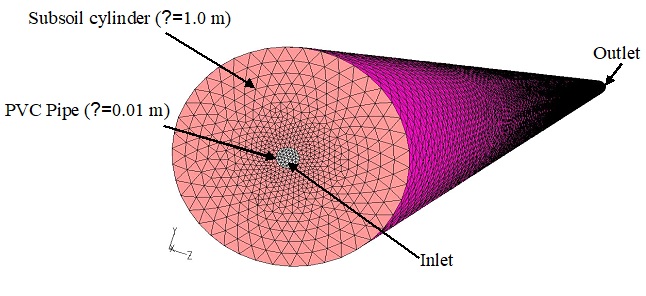Computational Studies of Earth Air Heat Exchanger using CFD: Parametric Analysis

DOI:
https://doi.org/10.54060/jmce.v3i1.29Keywords:
Earth air tunnel heat exchanger, computational fluid mechanics, parametric studyAbstract
Parametric studies of earth air tunnel heat exchanger (EATHE) using FLUENT 6.3 Com-putational fluid dynamics (CFD) software have been carried out in this paper. From the parametric analysis it is found that economic analysis of the system is required for the optimization of length, diameter, and depth of buried pipe. For a long earth air tunnel more than 60 m, soil thermal conductivity doesn’t give any significant effect. The higher mass flow rate also increases the overall energy conservation potential of the system, but it reduces thermal comfort. So, the mass flow rate also takes to optimize according to the requirement. This study is beneficial to the design and energy researchers of this field.
Downloads
References
S. Lal, S. C. Kaushik, P. K. Bhargava, “A study on stack ventilation system and integrated approaches,” Conference on Emerging trends of energy conservation in buildings CBRI Roorkee India, no.1-3, pp.255-263, 2012.
Fourth Assessment Report of the Intergovernmental Panel on Climate Change: Climate Change Mitigation, chapter 6, Cambridge University Press, 2007.
M. S. Sodha, U. Mahajan and R. L. Sawhney, “Thermal performance of a parallel earth air pipes system,” International Journal of Energy Research, vol.18, pp.437–477, 1994.
G. Sharan, R. K. Sahu, R. Jadhav, “Earth-tube heat exchanger-based air-conditioning for tiger dwellings,” Zoos Print, vol.16, no.5, 2001.
R. Kumar, S. Ramesh, and S.C. Kaushik, “Performance evaluation and energy conservation potential of earth air tunnel system coupled with non-air-conditioned building,” Building and Environment, vol.38, no.6, pp.807–813, 2003.
G. Mihalakakou, M. Santamouris, and D. Asimakopoulos, “Modelling the thermal performance of earth-to-air heat exchangers,” Solar Energy, vol.53, no.3, pp.301–305, 1994.
M. S. Sodha, R. L. Sawhney, B. C. Jayashankar, et al., “Effect of different earth surface treatments on the thermal performance of a room coupled to an earth-air tunnel,” International Journal of Energy Research, vol.14, pp.337–354, 1990.
S.C. Kaushik, T. Garg and S. Lal, “Thermal Performance Prediction and Energy Conservation Potential Studies on Earth Air Tunnel Heat Exchanger for Thermal Comfort in building,” Journal of renewable and sustainable energy (JRSE-AIP), vol.6, no.1, pp.1-12, 2014.
N. K. Bansal, M. S. Sodha, and S. S. Bharadwaj, “Performance of earth air tunnels,” Energy Res, vol.7, no.333, 1983.
M.S. Sodha, A.K. Sharma, S.P. Singh, et al., “Evaluation of an earth air tunnel system for cooling/heating of a hospital complex,” Building and Environment, vol.20, no.2, pp.115–122, 1985.
S. P. Singh, “Optimization of earth air tunnel system for space cooling,” Energy conversion management, vol.35, no.8, pp.721–725, 1994.
A. Trombe, L. Serres, “Air-earth exchanger study in real site experimentation and simulation,” Energy and Buildings, vol.21, no.2, pp.155–162, 1994.
M. Santamouris, G. Mihalakakou, C.A. Balaras, et al., “Energy conservation in greenhouses with buried pipes,” Energy, vol.21, no.5, pp.353–360, 1996.
N. M. Thanu, R. L. Sawhney, R. N. Khare, et al., “An experimental study of the thermal performance of an earth-air-pipe system in single pass mode,” Solar Energy, vol.71, no.6, pp.353–364, 2001.
R. Kumar, S.C. Kaushik and S.N. Garg, “Heating and cooling potential of an earth to air heat exchanger using artificial neural network,” Renewable Energy, vol.31, no.8, pp.1139–1155, 2006.
V. Bansal and J. Mathur, “Performance Enhancement of Earth air tunnel heat exchanger using evaporative cooling,” Lowarbon Technologies, vol.4, no.3, pp.150-158, 2009.
V. Bansal, R. Misra, G. D. Agrawal, et al., “Performance analysis of earth pipe air heat exchanger for winter heating,” Energy and Buildings, vol.41, no.11, pp.1151–1154, 2009.
M. Zukowski, B. Sadowska, W. Sarosiek, “Assessment of the cooling potential of an earth-tube heat exchanger in residential buildings,” The 8th International Conference on environmental engineering, Vilnius Lithuania, pp. 830–834, 2011.
S.C. Kaushik, S. Lal and P.K. Bhargava, “Earth air tunnel heat exchanger for building space conditioning: A critical Review,” International journal of Nano-materials and Energy (ICE), vol.2, no.4, pp.216-227, 2013.
S.C. Kaushik and G. S. Kumar, “Performance evaluation of an earth air tunnel for space heating of a non-air-conditioned building,” International Journal of Ambient Energy, vol.15, no.4, pp.1–12, 1994.
A.S. Dhaliwal and D.Y. Goswami, “Heat transfer analysis environment control using an underground air tunnel,” ASME Solar Energy Div. Las Vegas, vol.107, no.2, pp.141–145, 1986.
M. Krarti and J.F. Kreider, “Analytical model for heat transfer in an underground air tunnel,” Energy Conversion and Management, vol.37, no.10, pp.1561–1574,1996.
S. Lal & S. C. Kaushik, “CFD Simulation Studies on Integrated Approach of Solar Chimney and Earth Air Tunnel Heat Exchanger for Building Space Conditioning,” International Journal of Economy Energy and Environment, vol.2, no.3, pp.32-39, 2017.
S. Lal & S. C. Kaushik, “Comparative study of Earth Air Tunnel and Borehole Heat Exchanger applied for Building Space Conditioning,” Presented and published in TRACE paper published in Springer nature- Advances in Energy and Built Environment, vol.36, pp.1-12, July 2019.
S. Lal, “Green Building Design Concept: A Sustainable Approach,” Journal of Mechanical and Construction Engineering, vol.2, no.1, pp.1-10, 2022.
S. Lal, “Significance of Energy Efficient component in the Buildings Design towards the Green Footprint,” Submitted in the Journal of Mechanical and Construction Engineering, vol.2, pp.1-13, 2022.
V. Bansal, R. Mishra, G. D. Agrawal et al.,“Derating Factor’ new concept for evaluating thermal performance of earth air tunnel heat exchanger: A transient CFD analysis, ” Applied Solar Energy, vol.102, pp.418-426, 2013.

Downloads
Published
How to Cite
CITATION COUNT
Issue
Section
License
Copyright (c) 2023 Dr. Shiv Lal

This work is licensed under a Creative Commons Attribution 4.0 International License.
























